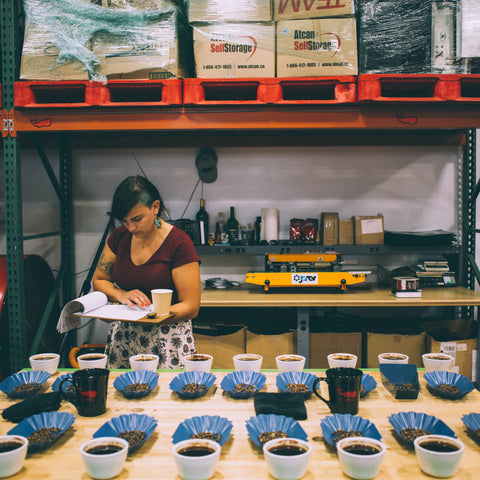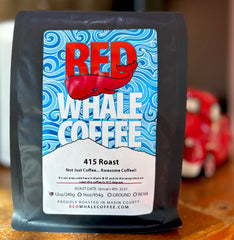Slurp it up! A Red Whale Cupping Experience September 22, 2015
Experiencing a Red Whale Cupping

The table is set. Cups arranged in a precise row, trays of sample-roasted beans sit before it, tasting spoons lined neatly along the table, and cupping sheets roosted on each of our clipboards. In the cups, freshly ground coffee from our producer’s sit, awaiting hot water and the start of the cupping.
Coffee cupping is serious business. Everything from the water temperature to grinding the beans fresh to timing each step of the cupping matters. A cupping takes concentration and developing one’s palate to the sophisticated range of flavors each cup offers.
Why is cupping important?

A cupping is a coffee tasting. The cupping allows Q-Graders and other coffee aficionados to grade the coffees and decipher the cupping notes of each coffee. This is also part of the dynamic nature of direct trade coffee, we can communicate with producers after the cupping and discuss what defects were found or where the coffee was exceptional. The producer sends samples of their green coffee beans to the roaster, who roasts and then cups them to pinpoint which beans to buy.

The Different Steps of a Coffee Cupping
Fragrance/ Aroma:

After grinding the coffee, the cupper will take in the aroma of the freshly ground coffee, while surveying the whole beans on the table to note quakers and other defects visible to the eye. The cupper scores the dry coffee and notes which fragrances he picks up.

After judging the dry aroma, the cupper adds hot water to the cup, wetting all grounds and filling it to the brim. After the coffee sits for three to five minutes, the cupper “breaks” the crust, cracking the grounds at the top of the coffee and swirling it with the spoon three times to bring up the aroma.
Tasting:
After notes are gathered on the aroma, it’s on to the next step, tasting the coffee! Coffee is tasted when it has reached the right temperature to sip (a burnt tongue will ruin the tasting experience).
The sip:

Tasting coffee requires that you take a quick sip in. Don’t be afraid to slurp! This quick slurp allows you to pull the coffee into your mouth and taste it across your entire palate.
The first step of evaluating the coffee happens when it has reached around 160 degrees. At these hotter temperatures, one rates the flavor and aftertaste. Next the acidity, body, and balance are rated. As it cools down to room temperature the sweetness, uniformity and cleanliness is evaluated. Then the coffee is added up and scored.

Watch out for defects!
A defect is when something is “off” in the coffee. These negative flavor characteristics can come off as an aroma (or taint) or in the taste (as a fault). These cause the score in intensity to be rated lower (taints are scored at 2, and faults at 4). A defect can have a description like rubbery or sour; those tastes that make you cringe.
The Final Breakdown:

Each of these characteristics helps the cupper break down different aspects of a good cup of coffee. It is then scored and receives a grading 0 and 100. Red Whale Coffee only serves specialty-graded coffee, which means no scores lower than 80 will be served.
Stay tuned for more information on a coffee cupping at Red Whale Coffee! Become part of the coffee process and get the opportunity to learn more about the different characteristics found in coffee.
Blog by Caitlyn Prien



